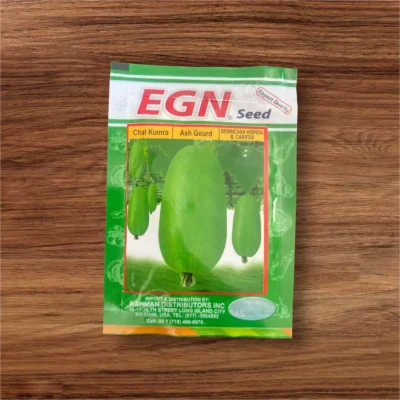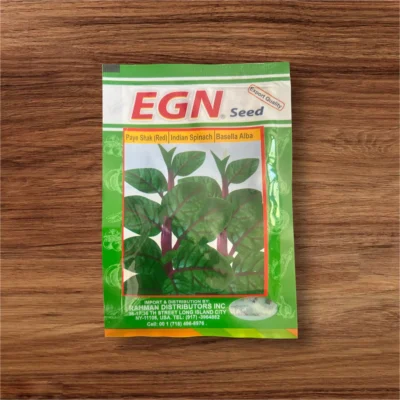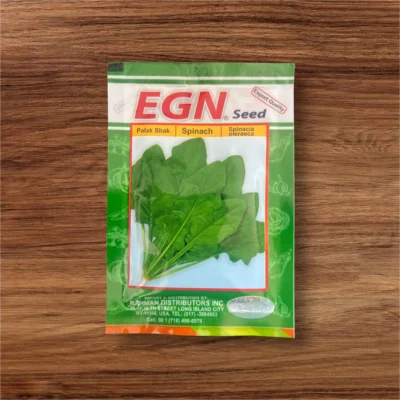Ridged Gourd Seeds – Gingha Luffa Acutangula | Angled Loofah Seeds
Original price was: $7.00.$4.99Current price is: $4.99.
Grow authentic Gingha (Ridged Gourd) with premium Luffa Acutangula seeds. Perfect for curries & soups. Heat-tolerant climbing variety. 12-15 seeds. Fast shipping!
100 in stock (can be backordered)
Product Overview
Cultivate authentic Gingha in your garden with our premium ridged gourd seeds, the traditional angled loofah variety prized in South Asian cuisine for its unique texture and delicate flavor. These Luffa acutangula seeds produce vigorous climbing vines that yield abundant harvests of distinctively ridged vegetables perfect for curries, soups, and traditional cooking.
Product Details
- Weight: 0.013 lbs (approximately 6 grams)
- Seed Count: Approximately 12-15 premium seeds per package
- Scientific Name: Luffa acutangula
- Common Names: Gingha, Ridged Gourd, Angled Loofah, Chinese Okra, Silk Gourd, Ribbed Gourd
- Origin: Sourced from traditional South Asian suppliers
- Germination Rate: 85-90% under optimal conditions
- Organic: Yes, naturally grown without chemical treatments
Why Choose Our Gingha Seeds?
Authentic Traditional Variety
Our Gingha seeds produce the genuine ridged gourd variety that has been cultivated for centuries in Bangladesh, India, and Southeast Asia. These aren’t commercial hybrids—they’re the authentic seeds that yield the same distinctively angled, ridged gourds used in traditional family recipes.
Superior Climbing Performance
These vigorous climbing plants can reach 12-15 feet in height and produce 20-30 gourds per vine when properly supported. The strong vines are excellent for creating natural shade screens while producing abundant harvests throughout the growing season.
Exceptional Culinary Versatility
Gingha’s unique ridged texture and mild, slightly sweet flavor make it perfect for absorbing spices in curries, adding substance to soups, and creating traditional stir-fries. The tender flesh cooks quickly and maintains its shape beautifully in various preparations.
Growing Your Ridged Gourd
Planting Instructions
Best Planting Time: Start seeds indoors 3-4 weeks before last frost, or direct sow when soil temperature reaches 70°F (21°C)
Soil Requirements: Well-draining, fertile soil with pH 6.0-7.5. Prefers rich, organic matter-amended soil with good moisture retention
Spacing: Plant seeds 1 inch deep, spacing them 4-5 feet apart. Provide immediate support structure for climbing
Support Structure: Essential! Install strong trellises, arbors, or fencing 8-10 feet tall to support vigorous growth
Care & Maintenance
Watering: Maintain consistent soil moisture, especially during flowering and fruit development. Deep watering 2-3 times per week
Fertilization: Feed bi-weekly with balanced fertilizer during growing season. Increase phosphorus during flowering for better fruit set
Pruning: Remove excess male flowers and weak lateral branches to direct energy into fruit production
Pest Management: Generally pest-resistant, but monitor for cucumber beetles and squash vine borers
Harvest & Culinary Applications
Harvesting Guidelines
- Young & Tender: Harvest at 4-6 inches for most tender texture and mild flavor
- Mature Size: Allow to reach 8-12 inches for traditional curry preparations
- Peak Harvest: Most productive 60-80 days from planting during warm summer months
- Daily Picking: Check plants daily during peak season for optimal tenderness
Traditional Cooking Methods
Bengali Cuisine: Essential for authentic Gingha Tarkari, often cooked with potatoes, onions, and traditional spice blends
Indian Preparations: Perfect for Turai Sabzi, coconut-based curries, and dal preparations
Southeast Asian Dishes: Widely used in Thai and Vietnamese stir-fries and soups
Chinese Cooking: Traditional ingredient in Chinese okra dishes and hot pot preparations
Modern Culinary Uses
- Grilled or roasted as side dishes
- Added to Mediterranean vegetable medleys
- Stuffed with rice or meat fillings
- Pickled for preservation
- Used in fusion cuisine applications
Nutritional Benefits & Health Properties
Rich Nutritional Profile
- Dietary Fiber: Excellent for digestive health
- Vitamin C: Supports immune system function
- Vitamin A: Important for eye health
- Potassium: Essential for heart health
- Low Calories: Only 20 calories per 100g serving
Traditional Medicine Uses
In Ayurvedic medicine, ridged gourd is valued for its cooling properties and digestive benefits. Traditional practitioners recommend it for managing diabetes, supporting liver function, and maintaining healthy blood pressure levels.
Growing Tips for Maximum Yield
Climate Requirements
Optimal Conditions: Thrives in warm, humid conditions with temperatures between 75-85°F (24-29°C)
Season Length: Requires 100-120 frost-free days for full season production
Humidity Tolerance: Excellent choice for humid climates where other gourds may struggle with fungal issues
Support System Design
Trellis Construction: Use strong materials capable of supporting 50+ pounds of mature fruit
Spacing Considerations: Allow 6-8 feet between plants for adequate air circulation
Training Vines: Guide young vines onto supports to establish strong climbing patterns
Companion Planting
Grows exceptionally well with:
- Corn (provides natural climbing support)
- Beans and peas (nitrogen fixation benefits)
- Marigolds and nasturtiums (natural pest deterrent)
- Tomatoes and peppers (similar growing requirements)
Container Growing Guide
Urban Gardening Applications
Container Size: Minimum 20-gallon containers with excellent drainage
Support Systems: Install sturdy trellises or cages rated for climbing vegetables
Placement: Full sun locations with 6-8 hours direct sunlight daily
Mobility: Use wheeled bases for optimal sun positioning
Small Space Solutions
- Vertical growing on balconies
- Patio gardens with overhead supports
- Rooftop cultivation in hot climates
- Community garden plot optimization
Seed Saving & Propagation
Saving Seeds for Next Season
Allow 2-3 gourds to fully mature on the vine until they turn brown and lightweight. The interior will develop the characteristic loofah sponge structure, with seeds embedded in the fibrous material.
Processing Mature Gourds
- Remove seeds from dried loofah interior
- Clean thoroughly and dry completely
- Store in cool, dry conditions for 3-4 year viability
- Can also harvest loofah sponges for household use
Seasonal Growing Calendar
Spring Preparation (March-April)
- Start seeds indoors in cooler climates
- Prepare soil with organic amendments
- Install support structures
Summer Growing (May-August)
- Direct sow in warm climates
- Maintain consistent watering
- Begin harvesting young fruits
Fall Harvest (September-October)
- Continue harvesting for fresh use
- Allow select fruits to mature for seed saving
- Preserve excess harvest through pickling or freezing
Cultural & Historical Significance
Traditional Importance
Gingha has been cultivated for over 3,000 years across tropical Asia. In Bengali culture, it represents abundance and prosperity—a vegetable that provides both food and utility (as mature loofah sponges).
Modern Sustainability
As interest in sustainable living grows, ridged gourd offers dual purpose: nutritious food when young and natural cleaning sponges when mature, making it perfect for eco-conscious gardeners.
Troubleshooting Common Issues
Germination Problems
- Ensure soil temperature above 70°F
- Maintain consistent moisture without waterlogging
- Use fresh seeds for best results
Poor Fruit Set
- Hand pollinate if few pollinators present
- Ensure adequate nutrition during flowering
- Reduce nitrogen if excessive vine growth occurs
Pest Management
- Use row covers during early growth
- Encourage beneficial insects with diverse plantings
- Remove affected plants promptly to prevent spread
Package Contents & Quality Assurance
What You Receive
- Premium Gingha seeds (0.013 lbs package)
Our Guarantee
We stand behind the authenticity and viability of our ridged gourd seeds. If germination rates fall below 80% when proper growing conditions are provided, we’ll replace your seeds or provide a full refund within 30 days of planting.
Storage & Longevity
Store seeds in their original packaging in a cool, dry location away from direct sunlight. Properly stored Gingha seeds maintain viability for 4-5 years, with optimal germination when planted within 2-3 years of packaging.
Ready to grow authentic Gingha ridged gourd in your garden? Order these premium angled loofah seeds today and enjoy fresh, traditional vegetables that connect you with centuries of culinary heritage. Perfect for both experienced gardeners and those new to Asian vegetable cultivation!
Note: Seeds are for planting purposes only. Growing success depends on local climate conditions, soil preparation, and proper care practices.
| Weight | 0.013 g |
|---|
Only logged in customers who have purchased this product may leave a review.






Reviews
There are no reviews yet.